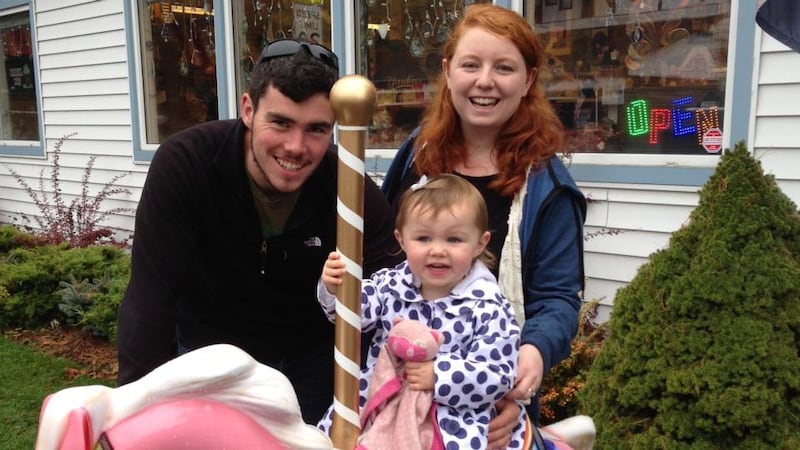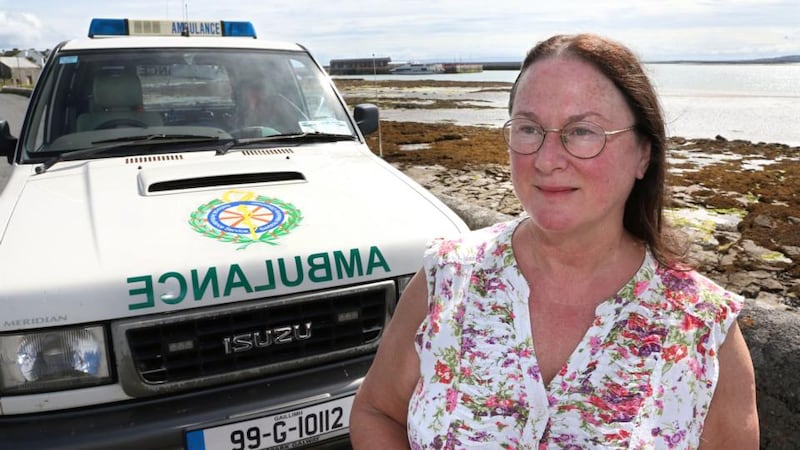When Sarah Walsh prepares her bag for maternity hospital in a few days’ time, she won’t be as obsessed with weather forecasts as she was when approaching her due date with Saidbh, her first child, who is two.
“Saidbh was a January baby and you couldn’t guarantee ferry sailings wouldn’t be affected,” says Walsh, who lives on Clare island, Co Mayo.
“To be honest, my parents were more worried than I was, whereas I kept saying I would be fine.”


Like most island women, Sarah’s mother, Mary McCabe, a school teacher, and grandmother, May McCabe, a postmistress, travelled out to the mainland several weeks before each delivery.
“That could be hard if you didn’t have family to stay with and if you had small children already at home,” Walsh says.
“I was lucky in that I had my in-laws in Westport and I stayed with my granny in Louisburg for a week after Saidbh’s birth. Many women had to, and sometimes still have to, book in to guest houses for that time. A summer birth is different,” Walsh adds.
Still, there are no guarantees; last month, the RNLI Achill lifeboat was called to Clare island when a young pregnant woman went into labour.
Medical corps
As with rescue agency staff and volunteers, Ireland’s small but highly effective offshore medical corps of doctors and nurses are trained for such close calls. In 1996, Mairéad Uí Fhlatharta gave birth to a daughter, Sorcha, in an Irish Coast Guard helicopter that was flying her from the Aran island of Inis Oírr to hospital in
Galway
.
In July 2013, paramedics Gary Robertson and John McCartney delivered a baby boy in mid-air as the Irish Coast Guard's Sligo-based helicopter flew from Arranmore island, Co Donegal, to Letterkenny General Hospital.
The establishment of what was originally called the Irish Marine Emergency Service in 1990, and consequent expansion of air/sea rescue and lifeboat cover, has transformed life for some 3,000 residents on islands and in more remote coastal communities.
Improved and more regularly subsidised ferry services have had a positive impact. Growth in tourism and technological change has also made island living more economically viable for young families with particular skills.
"In some ways, we are often in a better position here than Glencolumbille or some other isolated community on the mainland," says Dr Kevin Quinn, who has been the resident GP on Donegal's Arranmore island for the past 30 years. "When there is a real emergency, we can always call the helicopter."
Changed protocols
The problem now is that changed protocols and a more centralised HSE-led management system has resulted in cutbacks in less headline-making preventative and primary care, and overexpenditure in other instances.
For example, last month HSE West defended a decision to deploy two successive Irish Coast Guard helicopters to Inis Mór for an injured tourist who could have been transported to hospital on a regular Aer Arann commuter flight at a fraction of the cost.
Aer Arann flies regularly between the islands and Inverin in south Connemara, about 45 minutes by road from University College Hospital Galway, but national ambulance control informed the GP that it had no contract with Aer Arann and a helicopter would be sent for the patient.
The cost of the entire response has been estimated at €7,000, based on the average cost of helicopters at €2,300 an hour, compared with €400 at most for a chartered flight.
HSE West says the health services have a “long tradition” of working with the Air Corps and Irish Coast Guard on providing air ambulance, backed up by service level agreements. “Both of these emergency services have access to trained emergency staff and life- saving equipment. If a patient requires a 999 or 112 emergency response, it cannot be provided by a public transport service where personnel are not trained or where there is no emergency equipment,” HSE West said.
Comhdháíl Oileáín na hÉireann/the Irish Islands Federation and island GPs – just three of whom are resident, with several more commuting – stress that the standard of care by paramedics on board rescue helicopters is excellent, as is the training by RNLI volunteers.
However, island federation secretary Rhoda Twombly, who lives on Inishlyre, one of the many drowned drumlins dotted across Clew Bay in Co Mayo, recently undertook a survey that paints a worrying pattern.
Starting in the south, she found that Oileáin Chléire, or Cape Clear island, off the Cork coast, has been told that its 24-hour nursing cover is guaranteed only until the end of the summer. On Sherkin, Heir and Long islands, the nurse is present for only two hours a month.
On Bere island in Bantry Bay, 24-hour cover has been changed to two nurses sharing a five-day week service from 9am to 4pm.
It is a similar picture up the coast on the three Aran islands, where Dr Marion Broderick is on 24/7 duty, as her nurse is on fewer than 40 hours a week, with holiday nursing cover of only two days a week.
Problems arise when Broderick has to attend a stretcher case unaided or when a patient has to be sent to the mainland – with particular strain during the extended tourist season, when there can be up to 3,000 visitors a day and a Gaeltacht student population, Twombly points out.
Broderick used to have to serve all three islands; before air/sea rescue was improved, she had to commute by lifeboat and currach in all sorts of weather conditions.
The appointment of a second GP in 2003 to serve Inis Meáin and Inis Oírr – currently Dr Mirko Jugic – has eased pressure on her considerably.
However, on Inis Meáin the nurse is having difficulty securing cover, while on Inis Oírr, nursing cover has been cut to three days a week since the full-time nurse retired in April.
Two nurses fly to Inis Oírr to cover the three days, but if the flight is cancelled, as it often is due to fog, islanders have been told to ring the emergency telephone number.
This situation is very unsatisfactory when it might involve an elderly patient or someone who requires daily dressing changes, its co-op manager, Paddy Crowe, points out.
On Inishturk, with a population of 58 living nine miles off the Mayo coast in the Atlantic, the situation is particularly acute. It has a once-monthly clinic, administered by Dr Ciarán McLouglin who also serves Inishbofin, but its resident nurse retired last December and her position has not been filled.
"She is still coming out to us as she wouldn't leave us stuck, but there is no cover for her when she is gone, and no one else is authorised to use the defibrillator and medication," says Mary Catherine Heanue, who lives on Inishturk.
“We understand that position has been advertised, but we were told that we would get cover only if there was someone in full- time care, someone in bandages or someone pregnant,” she adds. “Otherwise, we were told, no cover is required.”
Telemedicine, as used in the Australian outback, does have some uses, but a system developed by Broderick on Inis Mór has run down as the HSE did not maintain it.
“The short life of technological devices is an issue and we don’t have fast broadband,” Dr Quinn on Arranmore points out. “You also have the reality that older people find it difficult to talk to a screen.”
Twombly says that while islanders do understand that the health system is under severe financial strain, it is “vital that the level of healthcare on the islands is not only maintained but, in cases where there have been reductions in the number of nurses employed and the hours that they work, restored to previous levels”.
Influx of tourists
As Thombly points out, it is not just an islanders’ issue. Populations multiply on many islands during the summer months and the influx of tourists and Irish language school students “increases the burden on doctors and nurses immensely”, she says.
It makes such positions almost unsustainable and very difficult to fill.
The island federation has recently raised the issue with former Fianna Fáil minister Éamon Ó Cuív, who is acknowledged to have done much to improve island services during his time in office.
He has in turn raised it in the Dáil and the HSE head of primary care, John Hennessy, has promised a review, beginning in September, with "consultation with all relevant stakeholders, including an island representative".
“We hope that this leads to a more comprehensive, realistic and cohesive delivery of healthcare on the islands,” Twombly says.
“Our one worry is that they will try to say we can make up the deficit by training first responders, but there is a big difference in being a first responder on the mainland, where you know back-up is not far away, and on an island, where you don’t.”










